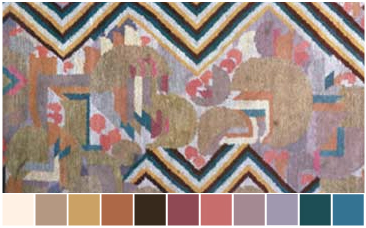User:0860816
Contents
Lizet van der knaap. Opleiding Mode
✄-------------
Stealing from the museum
Project week: Joeke, Remy, Denise en ik
Fantastic Forgeries
Fantastic Forgeries presents alternate histories of Dutch material culture through the research and evaluation of existing artefacts – and their appropriation, transformation and remaking. Fantastic Forgeries uses historical crafted objects as a departure point to reflect on the status and practice of craft in our contemporary society. The objects will be used as tools to examine traditional ways of making as well as a formal, tactile, and decorative inspiration to compare when stretching the boundaries of (artisanal/digital) fabrication.

Albert Van huffel, Gezusters De Saedeleer, Etikhove, Vloerkleed Mer (Zee), 1926 . Wol. 294 x 233 cm
The interest I have in carpets caused by the material, colour, technique, history and especially the prints. Each carpet has its own story. The colour and design can tell you where the carpet comes from and from which culture it originated.
Carpets can be produced on a loom quite similar to woven fabric, made using needle felts, knotted by hand (in oriental rugs), made with their pile injected into a backing material (called tufting), flatwoven, made by hooking wool or cotton through the meshes of a sturdy fabric or embroidered.
Different types of carpets
Woven
The carpet is produced on a loom quite similar to woven fabric. The pile can be plush(1) or Berber(2). Plush carpet is a cut pile and Berber carpet is a loop pile. There are new styles of carpet combining the two styles called cut and loop carpeting. Normally many colored yarns are used and this process is capable of producing intricate patterns from predetermined designs (although some limitations apply to certain weaving methods with regard to accuracy of pattern within the carpet). These carpets are usually the most expensive due to the relatively slow speed of the manufacturing process. These are very famous in India, Pakistan and Arabia.
https://www.youtube.com/watch?v=COBVGMEu2Zw
A closeup look at the Navajo rug weavers
(1)plush
Originally the pile of plush consisted of mohair or worsted yarn, but now silk by itself or with a cotton backing is used for plush.
(2)Berber
Made by Berbers in North Africa. Modern Berber carpet made from a wide variety of materials, Nylon, Olefin fiber, and wool.
Needle felt
These carpets are more technologically advanced. Needle felts are produced by intermingling and felting individual synthetic fibers using barbed and forked needles forming an extremely durable carpet. These carpets are normally found in commercial settings such as hotels and restaurants where there is frequent traffic.
https://www.youtube.com/watch?v=OO4JlEdubAQ
a needle felt machine
Knotted
On a knotted pile carpet (formally, a supplementary weft cut-loop pile carpet), the structural weft threads alternate with a supplementary weft that rises at right angles to the surface of the weave. This supplementary weft is attached to the warp by one of three knot types, such as shag carpet which was popular in the 1970s, to form the pile or nap of the carpet. Knotting by hand is most prevalent in oriental rugs and carpets. Kashmir carpets are also hand-knotted.
https://www.youtube.com/watch?v=oJO3N8wiE_A
technique of the knot
Tufted
These are carpets that have their pile injected into a backing material, which is itself then bonded to a secondary backing made of a woven hessian weave or a man made alternative to provide stability. The pile is often sheared in order to achieve different textures. This is the most common method of manufacturing of domestic carpets for floor covering purposes in the world.
https://www.youtube.com/watch?v=fO3-EmCTknc
Making of Hand Tufted Carpets
flatweave carpet
A flatweave carpet is created by interlocking warp (vertical) and weft (horizontal) threads. Types of oriental flatwoven carpet include kilim, soumak, plain weave, and tapestry weave. Types of European flatwoven carpets include Venetian, Dutch, damask, list, haircloth, and ingrain (aka double cloth, two-ply, triple cloth, or three-ply).
https://www.youtube.com/watch?v=PTJ918L-pro
flatweave technique
hooked rug
A hooked rug is a simple type of rug handmade by pulling strips of cloth such as wool or cotton through the meshes of a sturdy fabric such as burlap. This type of rug is now generally made as a handicraft.
https://www.youtube.com/watch?v=dFkqnT8Czng
hooked rug technique
Twinning
Twinning is a method of combining two fabrics onto one rug
https://www.youtube.com/watch?v=ZWQqUsGGphk
twinning technique
My Replica
To make a replica i want to know as much as possible about the carpet of Albert van Huffel. This was a little disappointing because there is not so much information about his carpets because he is more famous as an architect. But i looked up some information where the carpet is made and send an email to the factory who made the carpet in this time. I asked if they have more information for me.
I would like to create a copy of this carpet by using the graphic print. I want to replace the material and technique. The similarity between old carpets is that they are often woven. My goal is to copy it to another rug weaving technique which I develop myself through technology. I will also, where possible, use other materials. If i can I will use natural materials to dye them and try to create the same colour.
Vloerkleed Albert Van huffel
In 1925-1926 ontwerpt architect Albert Van huffel de woning voor aannemer Bruxelman in Ledeberg Gent. Naar goede gewoonte staat hij ook in voor de vormgeving van interieur en meubilair. Van huffel vertrouwt de uitvoering van de vloerkleden toe aan Elisabeth De Saedeleer, een collega aan de kunsthogeschool La Cambre. Zij leidt in Etikhove een ambachtelijke tapijtweverij en -knoperij. Hier laat Van huffel zich vaak van zijn meest exuberante zijde zien. Een fel bewogen ritmiek van geometrische zigzagmotieven in strek contrasterende kleuren maakt het textiel tot een bewogen zee. (bron: Design Derby boek)
